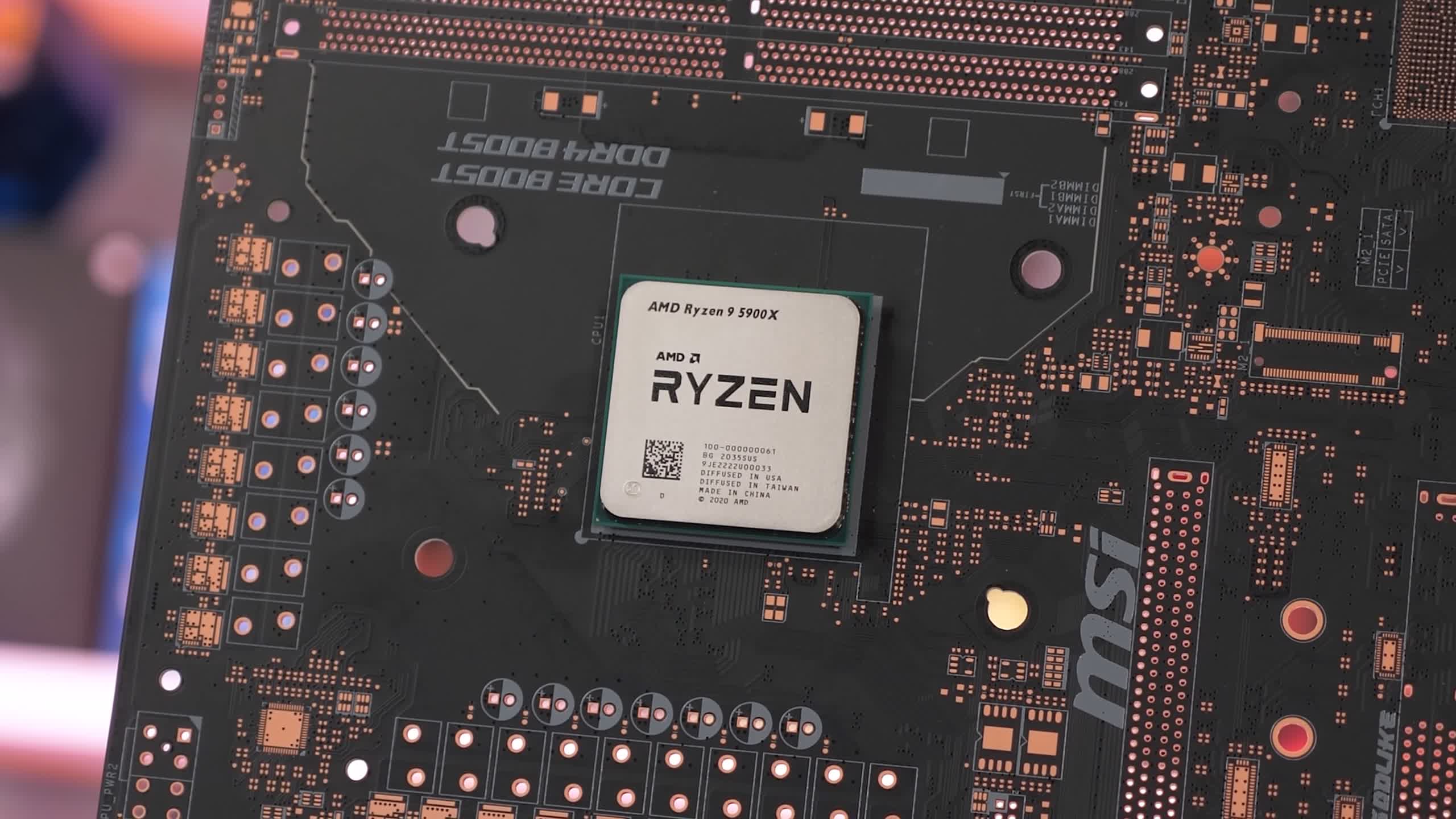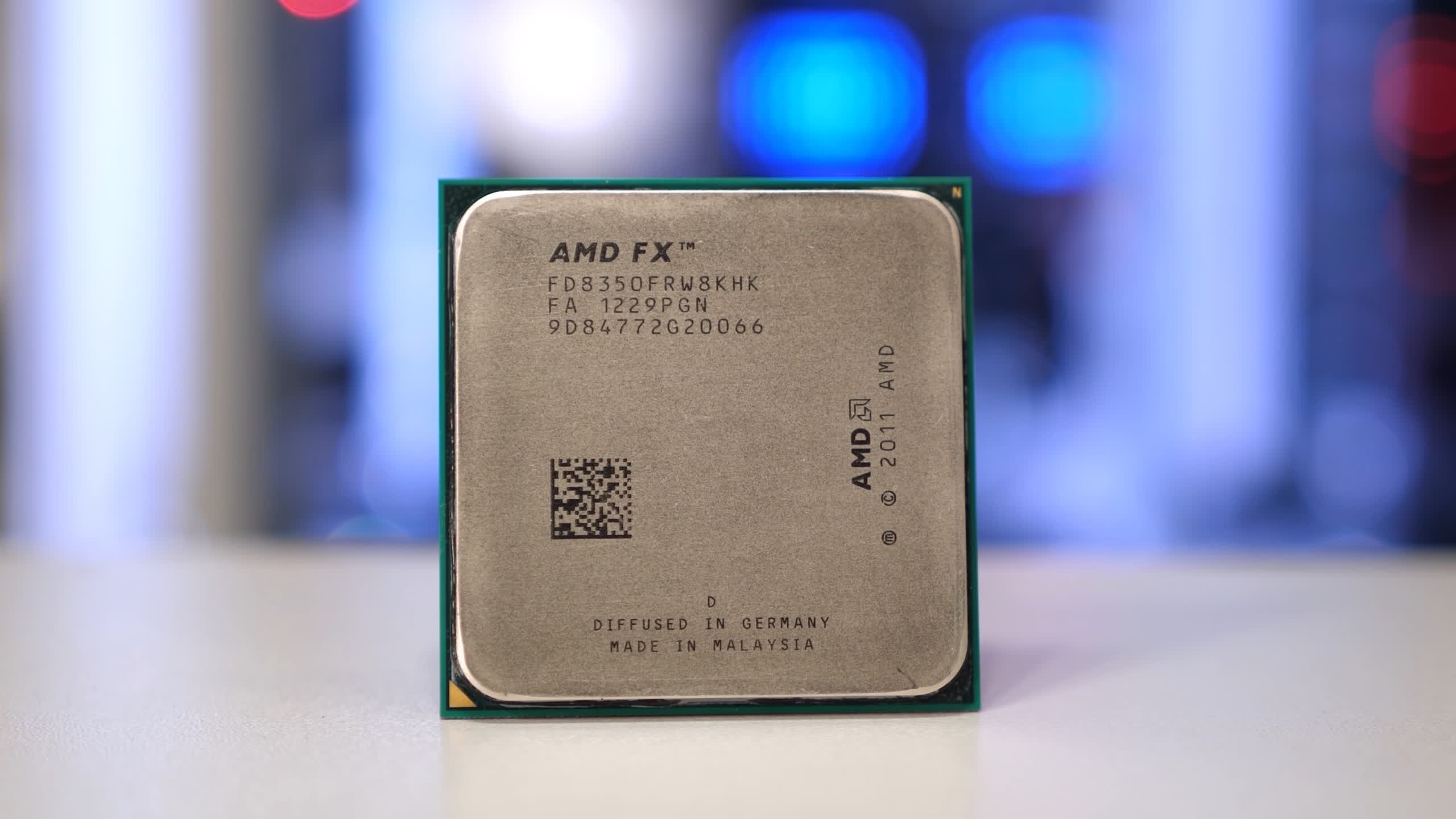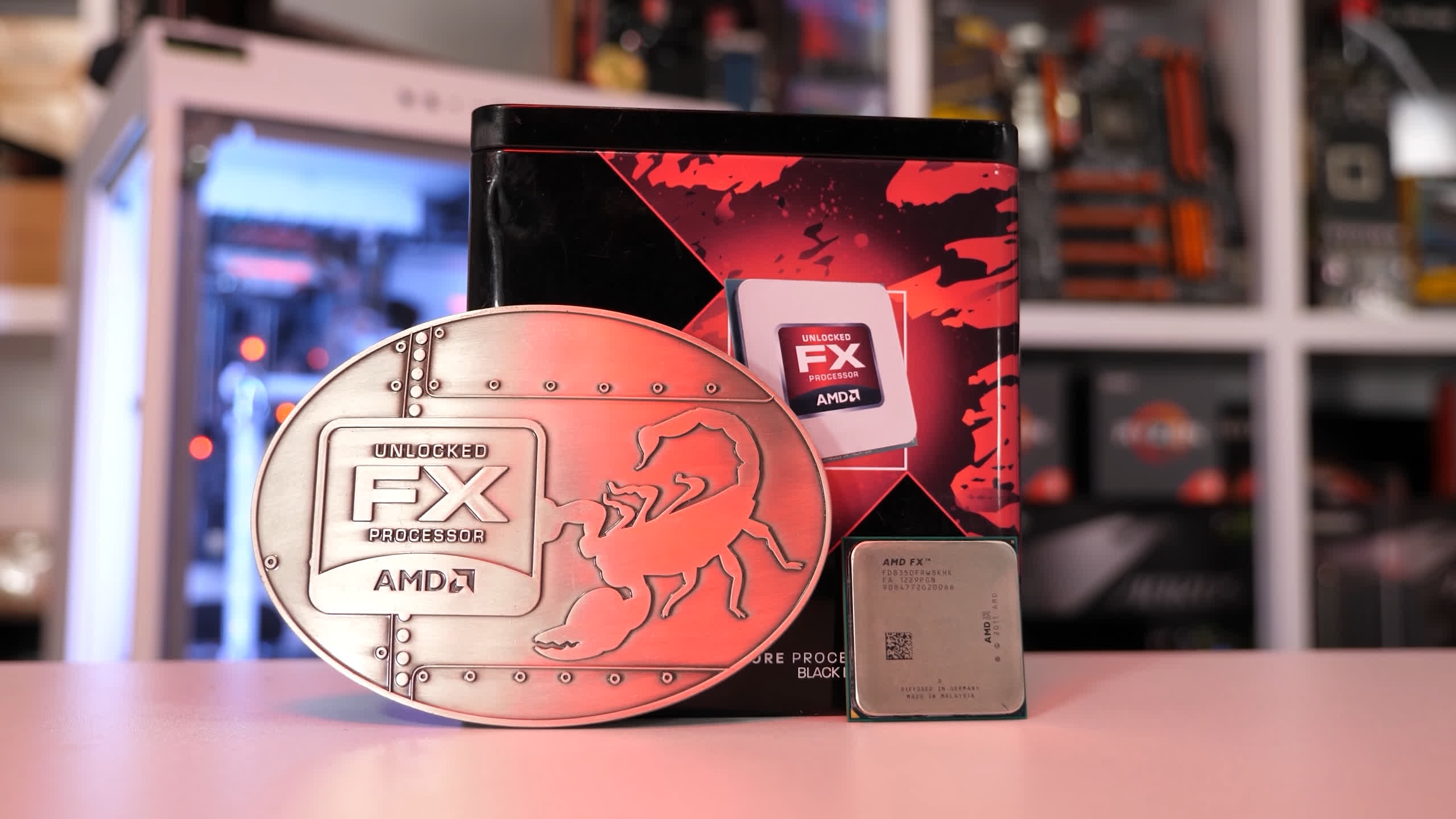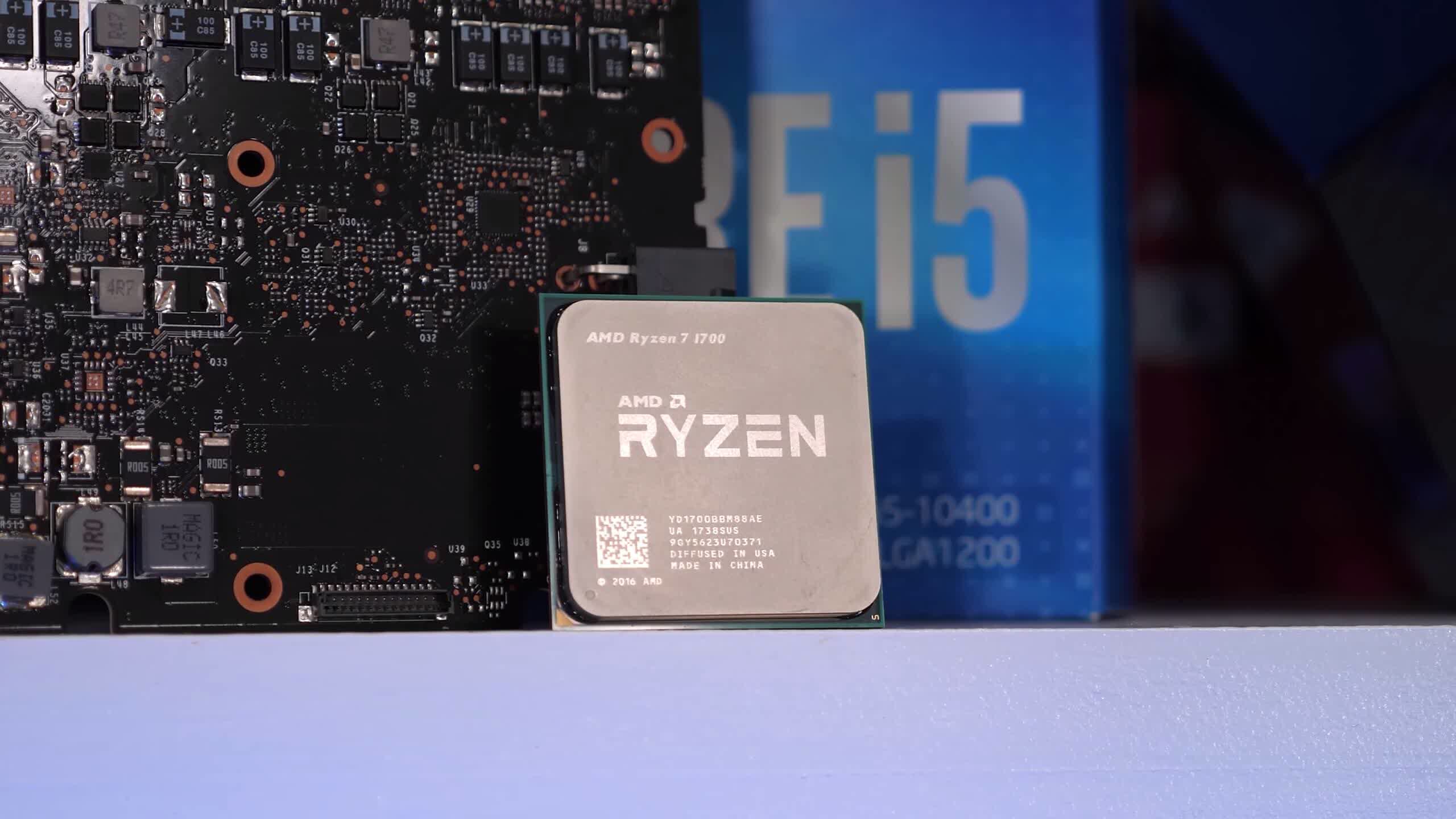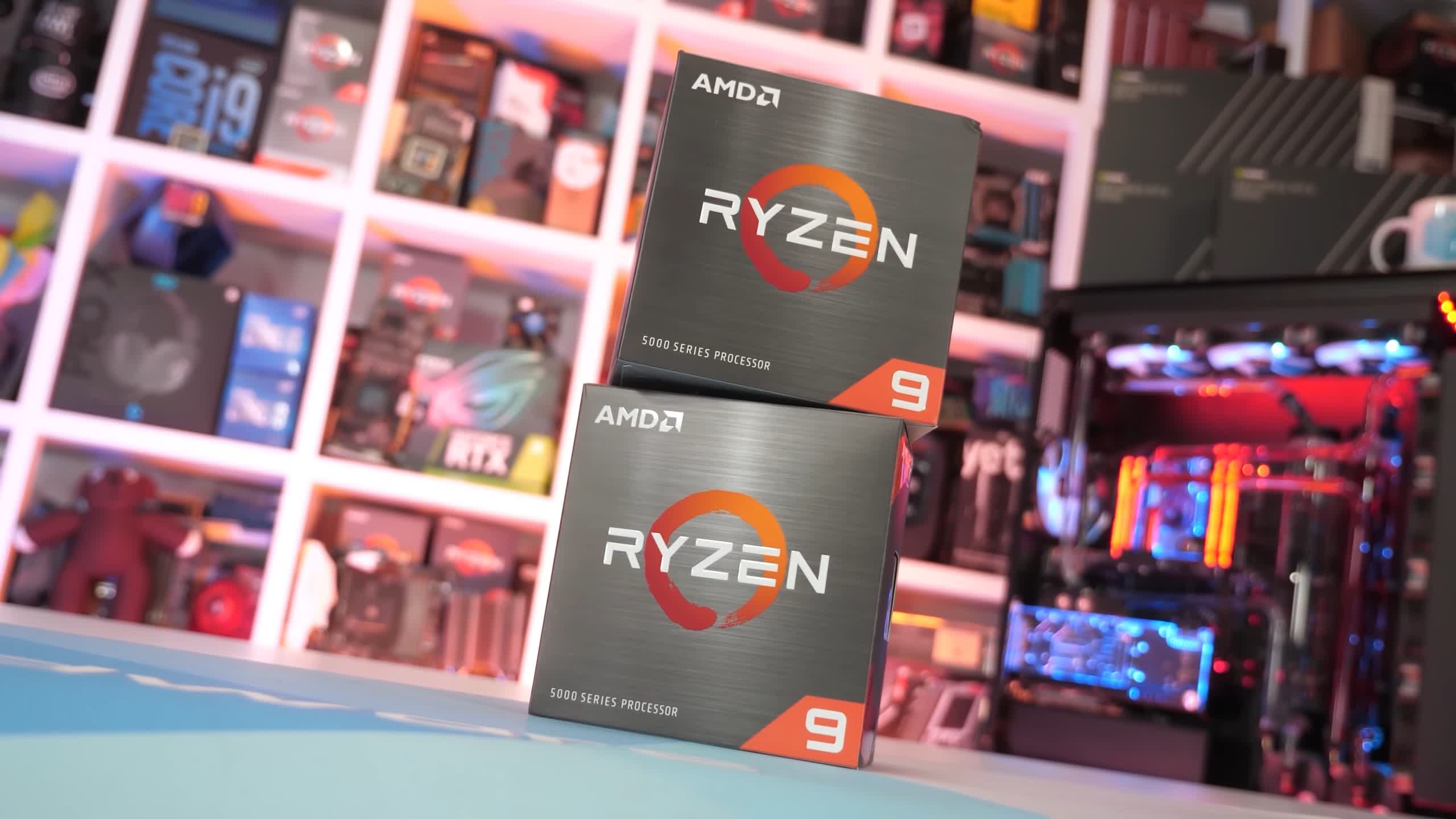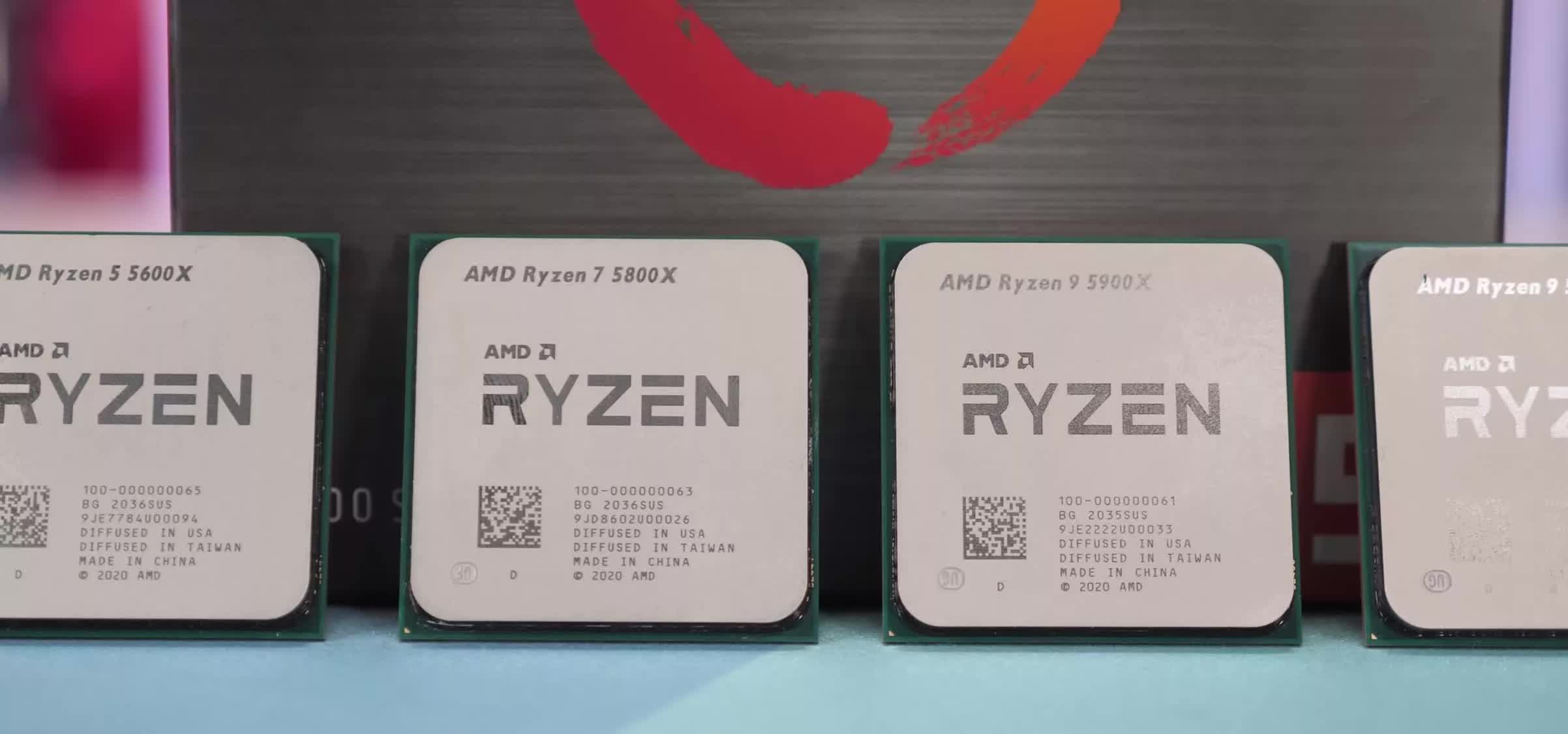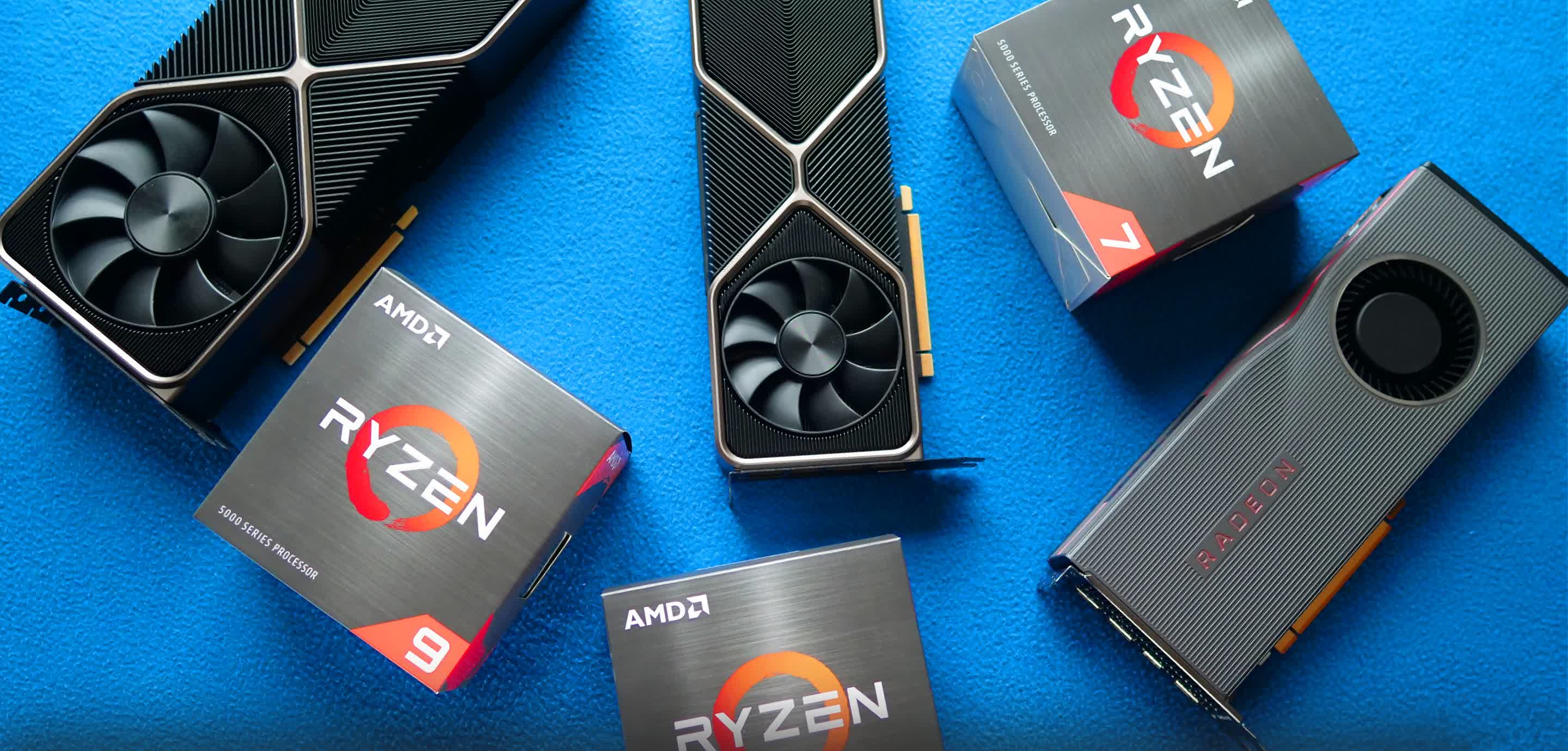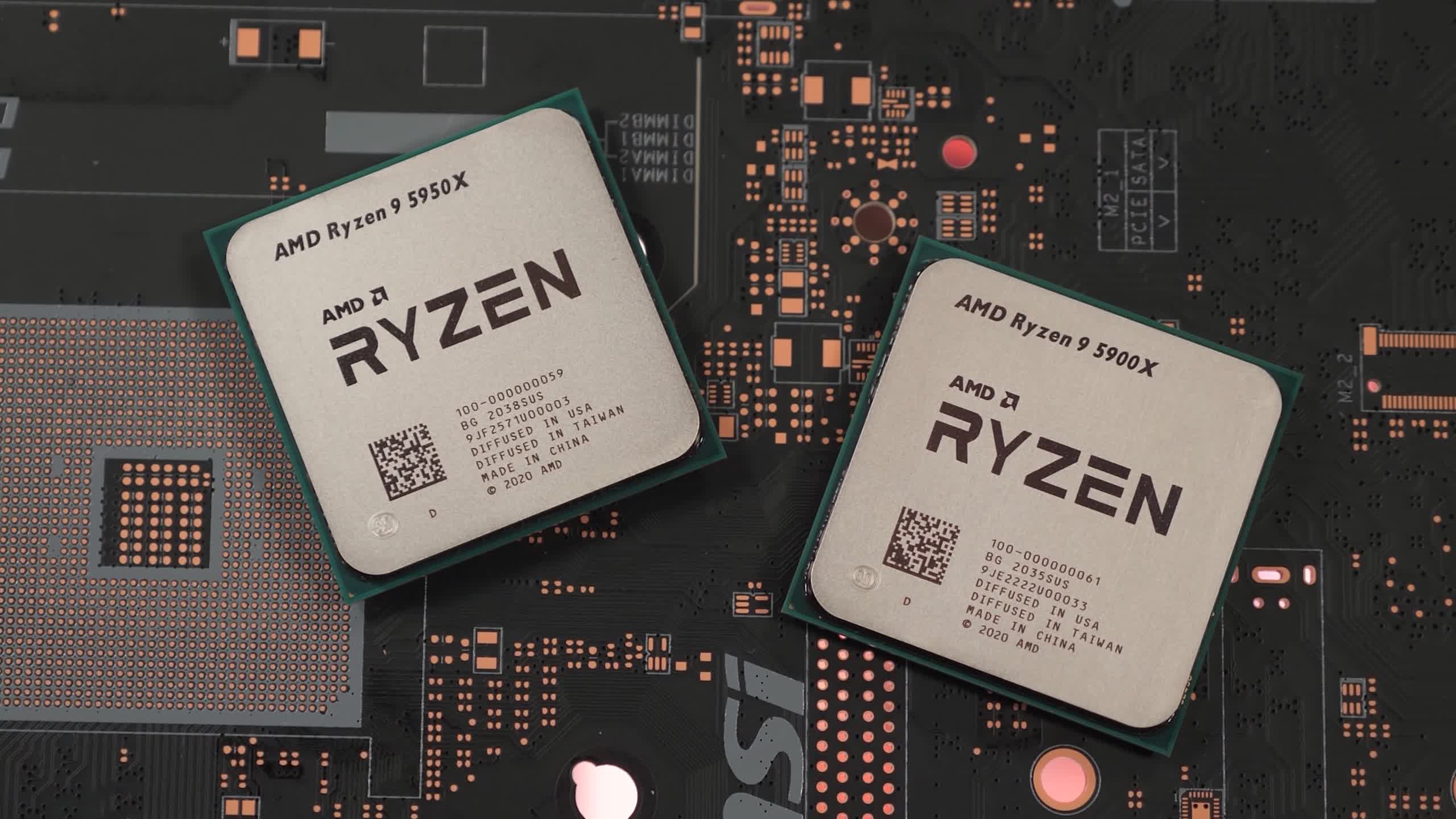Recently we took an interesting look at how much progress Intel CPUs have made over the past six years, testing 5th-gen Core against 10th-gen Core processors' gaming performance. We covered two angles: first we isolated gains that have come from increasing the operating frequency, and second what they achieved by adding more cores. This gave us a clear picture of the architectural refinements Intel's achieved while stuck on their 14nm process.
Of course, over the years they've also achieved much greater operating frequencies while also expanding the core count. That being the case, we also took a look at how increasing to 6, 8 and even 10 cores has improved gaming performance, though we did ignore the frequency gains as that's been well explored at this point and frequency scaling is more predictable. Ultimately, we found that Intel's journey on the 14nm process has seen limited improvements from 5th-gen to 10th-gen, amounting to a ~10% jump in gaming performance, when comparing CPUs at the same core count and operating frequency, and that gain includes the transition from DDR3 to DDR4.
By far, the biggest performance gains for Intel have come from increasing L3 cache capacity, cranking up the operating frequency near to its limit, and of course, adding more cores. Essentially, Intel could have created their 2020 10th-gen lineup five years before with Skylake, but because there was no competitive pressure, they didn't see the need and therefore cashed in on smaller 122mm2 dies.
Speaking of the competition, today's review is all about AMD's own progress using the same testing methodology. We'll be comparing flagship parts of each generation with just 4 cores enabled at a fixed frequency, along with some current-gen parts running with all cores enabled.
Without even looking at any new numbers, we acknowledge this could paint AMD in a more positive light as we're bound to highlight the massive gains the company has achieved since the FX days and now on Ryzen's latest generation. However, the fact is that the company's CPUs have come from miles behind Intel as AMD was mostly irrelevant during the FX era.
So let's talk about what exactly we're looking at here...
We're going back to 2012 when AMD released the FX-8350 based on the Piledriver core using GlobalFoundries' troubled 32nm process. Technically, the first FX series processors arrived a year prior and were codenamed Bulldozer, but we're going to skip the FX-8150 and that entire series, we really only need one FX processor and we might as well go with with the "best," and I do like to use that term loosely when discussing FX processors.
There was also the FX-8370 which arrived two years later and was the same CPU, as well as the super dumb FX-9370 and 9590 which were essentially the same parts again but with an increased TDP of 220 watts, or almost 80% higher than the 8350 (!). These were just overclocked models and in the case of the FX-9370 and FX-9590, the base and boost frequencies weren't even improved by 20%.
Because we're testing all parts at 4.2 GHz, we went with the FX-8350 and locked it at that frequency. We're also testing with only 4 cores enabled, but since the FX series only went up to 4 cores with 8 threads, we haven't had to make any changes here. Some might still argue that the FX-8350 is an 8 core CPU, but it's not, and it's certainly not according to the California Consumers Legal Remedies Act. In 2015, AMD was successfully sued for allegedly misrepresenting the specifications of Bulldozer chips and in August 2019, AMD agreed to settle the suit for $12.1M.
The latest motherboard BIOS revisions still claim the FX-8350 is an 8 core processor while Windows states it's a 4 core CPU with 8 logical processors, so basically a quad-core with SMT support. For testing the FX-8350, we're using the Asus M5A99FX Pro R2.0 with DDR3-2400 CL11-13-13-31 memory.
Then for comparison we have the Ryzen 7 1800X, 2700X, 3800X and 5800X. With the exception of the 1800X, we limited all CPUs to 4 cores running at 4.2 GHz. The 1800X still ran with just 4 cores enabled, but they were clocked at 4.1 GHz as that was the highest stable frequency I could achieve with that part.
We've also included the Ryzen 5 5600X and Ryzen 9 5950X for 6 to 16-core comparisons and these can be directly compared with the FX-8350, though they are at a clock speed disadvantage given they're underclocked at just 4.2 GHz.
The Ryzen 7 2700X up to the 5000 series were tested on the Gigabyte X570S Aorus Master, while the 1800X was tested on the MSI B450 Tomahawk Max.
All Ryzen CPUs were paired with DDR4-3200 CL14 dual-rank, dual-channel memory with all primary, secondary and tertiary timings manually configured. Then finally all CPU configurations were tested with the Radeon RX 6900 XT. Let's check out the results...
Benchmarks
Starting with Rainbow Six Siege we see that the FX-8350 was good for 211 fps on average, which is obviously plenty of performance and this Vulkan title really doesn't require a great deal of CPU performance. That said, it was still miles slower than even the first generation Ryzen part with the 1800X offering almost 40% more performance, and remember only half the Ryzen CPU is enabled, though it is heavily overclocked.

The 2700X only offered a small upgrade from the 1800X, here we're looking at a 9% performance boost. Then as we know Zen 2 provided a sizable performance boost from Zen+, and in this example we're looking at a 23% increase in frame rate, taking the Radeon 6900 XT to 390 fps which is an incredible 84% increase over the FX-8350.
Then we see the biggest step forward with the introduction of Zen 3 and here the 5800X with half the cores enabled was 135% faster than the FX-8350, and this highlights just how bad the FX series was, limiting the performance of the 6900 XT by more than half.
For those wondering, the 5800X has been tested in a 4+0 configuration because AMD moved to an 8-core CCX with Zen 3, where as Zen 2, Zen + and Zen featured just 4-cores per CCX. Finally, it's interesting to see just a 9% performance increase when testing with Rainbow Six Siege when increasing the Zen 3 core count from 4 to 6 and then just a 10% performance increase when going from 4 to 16-cores.
Obviously this title doesn't heavily leverage the CPU and it's why the FX-8350 is able to deliver highly playable performance.
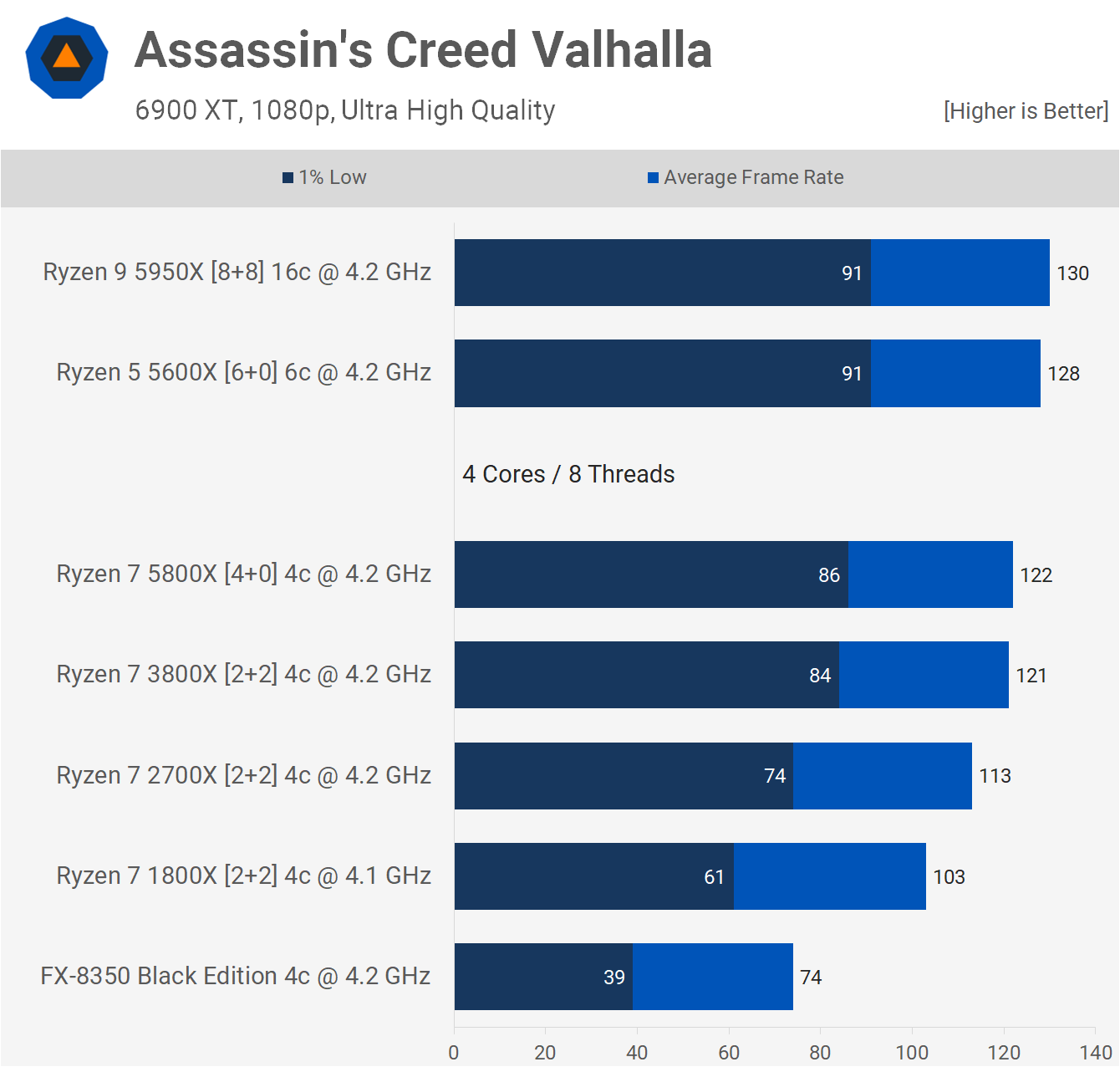
The experience playing Assassin's Creed Valhalla is very different, at least with the FX-8350. Whereas things remained very smooth in Rainbow Six Siege, constant stuttering was very noticeable when playing Valhalla with a 1% low result of just 39 fps. The 1800X boosted 1% low performance by almost 60% and this provided a significantly better gaming experience.
The 2700X was much faster again, boosting 1% low performance by a further 21% and then we came very close to maxing out the 6900 XT with the 3800X. In fact, the 4-core 5800X wasn't any faster while the full fledged 5950X only improved the frame rate by 7%.
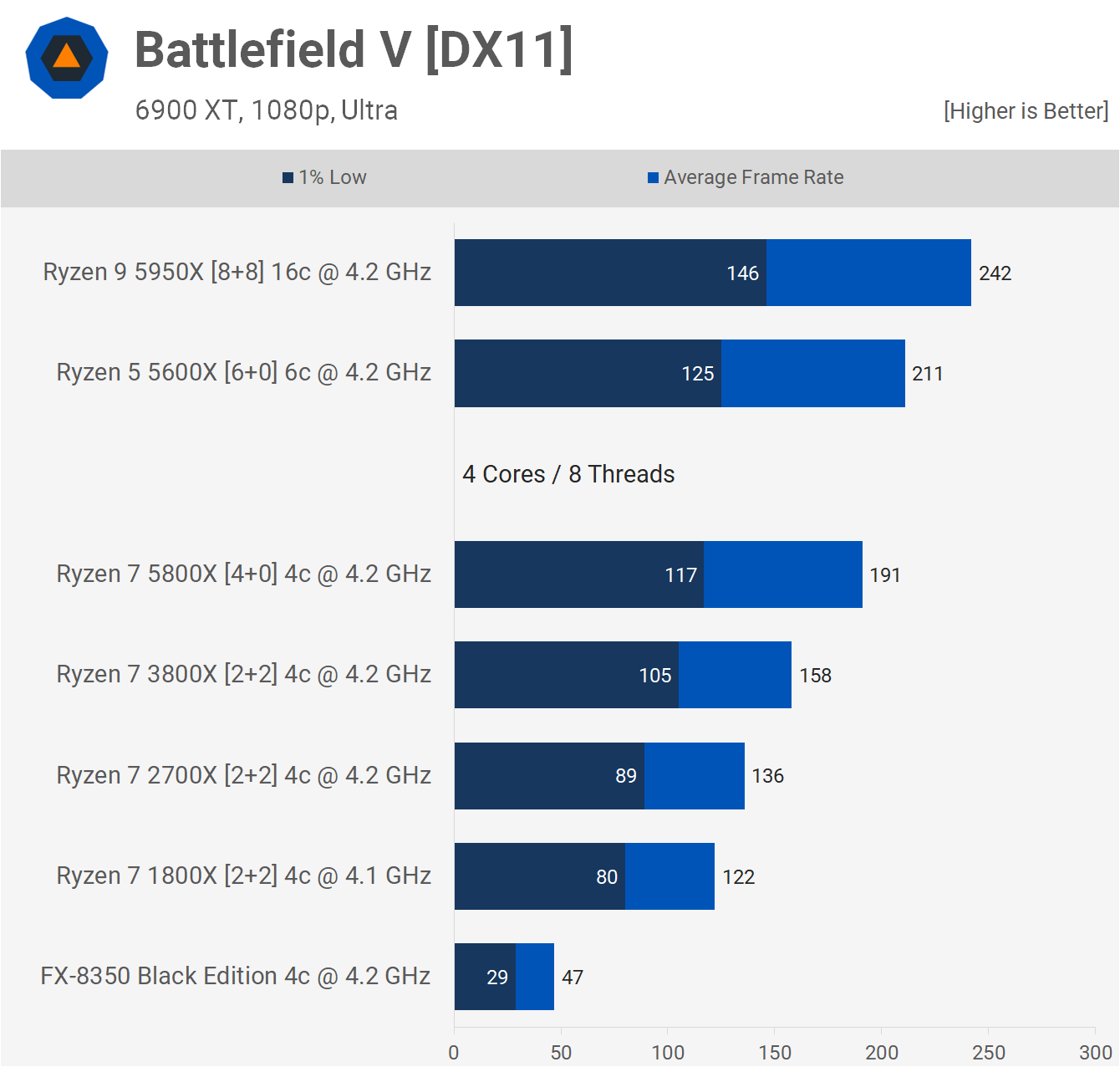
Battlefield V is a great example of just how bad the AMD FX series was, and of course, still is. It seems the more you leverage the FX processors, the more they fall apart. Low-level APIs like Vulkan which help bypass the CPU, resulting in significantly less CPU overhead, often play well with heavily underpowered CPUs, such as the FX-8350 and we just saw that a moment ago in Rainbow Six Siege.
But playing Battlefield V using the preferred DX11 API for this title, the FX-8350 crumbles. With just 47 fps on average and a 29 fps 1% low the game was completely unplayable by my standards and utterly useless for even semi-competitive gameplay, and remember we're using a Radeon RX 6900 XT for this testing.
The Ryzen 7 1800X, on the other hand, was 160% faster, that's a 160% performance uplift from one generation to the next for AMD, a failed generation to a somewhat successful generation. AMD were then able to improve performance by a further 11% with the Zen+ update and then another 16% with Zen 2, as the 3800X allowed for 158 fps on average.
Then with Zen 3 we see a further 21% performance increase hitting 191 fps, a 306% increase from the FX-8350.
Going from the 4-core configuration using the 5800X, performance in this title was boosted by 10% with 6-cores and then 27% with 16-cores. That means the Ryzen 9 5950X is offering 415% more performance than the FX-8350, wow.

F1 2020 isn't the most demanding title and it also supports DirectX 12. So here the FX-8350 does reasonably well and certainly enables an enjoyable and very playable gaming experience. Even so we're still looking at a 46% performance uplift with the 1800X, which again only has half the cores enabled for a more apples to apples comparison of the architectures.
Again AMD made a small step with 2nd-gen Ryzen, here the 2700X offered a 9% performance uplift and then we see a further 15% uplift with 3rd-gen. When we see a rather substantial 24% increase from the 3800X to the 5800X, hitting 266 fps.
Then when enabling more cores for the Zen 3 architecture, we see a 14-15% boost going from just 4 cores up to 16 cores. In this example, the 5950X was 162% faster than the FX-8350, and we're looking at a similar margin for the 6-core version.

Hitman 2 is far more CPU intensive than F1 2020 and this causes issues for the FX-8350. The game was more playable than Battlefield, but the experience with a 6900 XT wasn't ideal to say the least. The 1800X offered a 67% increase to the average frame rate and an improvement in 1% low performance of 82%, so the 1st generation Ryzen processor was miles faster.
We see similar performance improvements throughout the Ryzen generations, and by the time we hit Zen 3, AMD has improved performance from the FX-8350 by 147% when making a normalized core and frequency comparison.
Then from the 4-core 5800X configuration, the 6-core 5600X was 10% faster and the 16-core 5950X 21% faster. We're looking at roughly a 200% performance increase from the FX-8350 to the 5950X, with both CPUs running at 4.2 GHz.
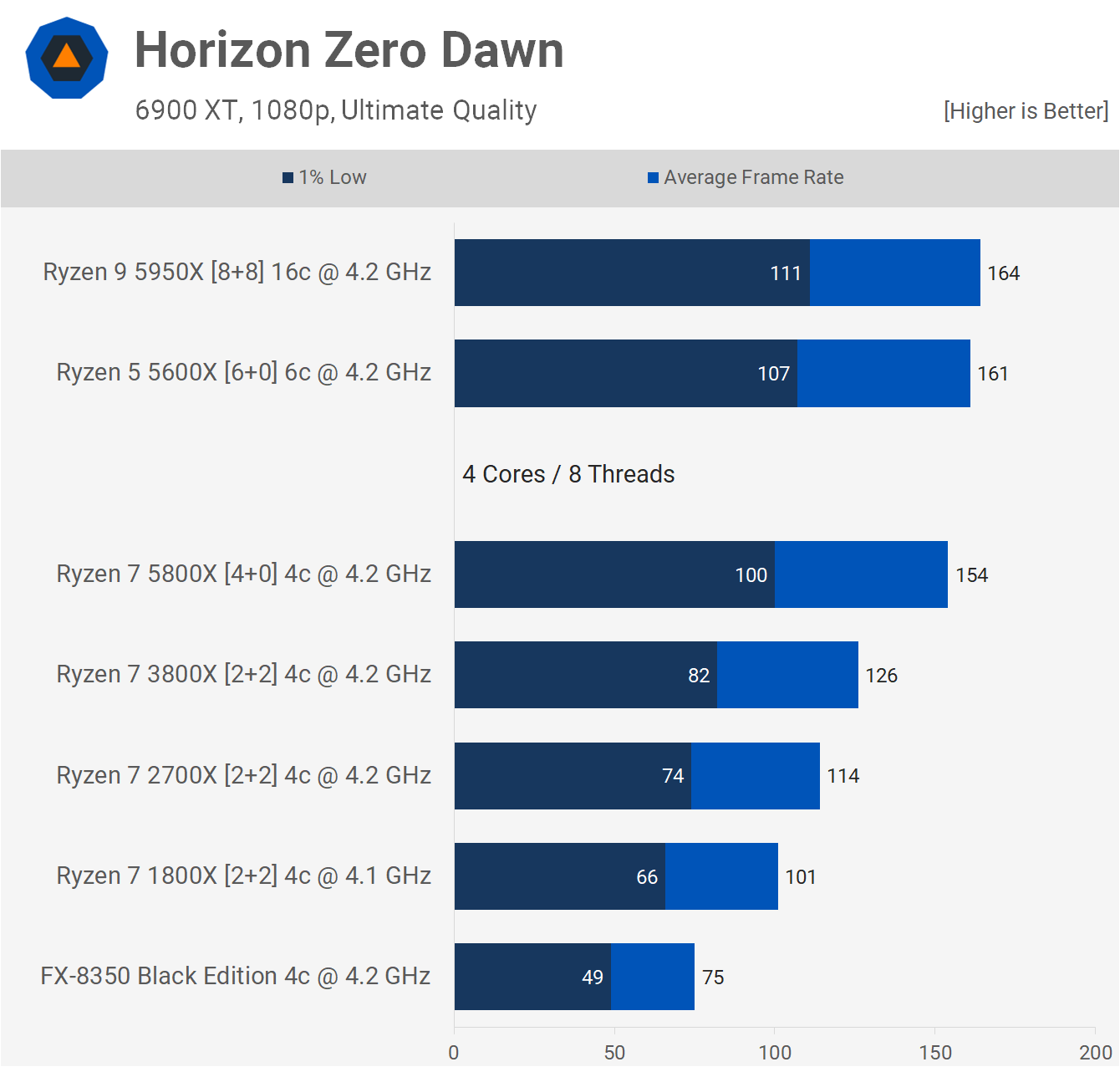
Horizon Zero Dawn plays well on the FX-8350 and what we have here is a game using a low-level API that's not particularly CPU demanding again. Even so, the 1800X with half its cores enabled offered 35% greater performance and by the time we reach the 5800X, which still only has half its cores enabled, we're looking at a 105% performance improvement from the FX processor.
Interestingly, adding more cores doesn't do much for this game, so if there was a quad-core Zen 3 CPU it would be more than capable of getting very near the most out of the 6900 XT in this game.

Cyberpunk 2077 is another game that makes use of a low level API, but this games is very CPU demanding and as a result the FX-8350 tanks, delivering a 1% low result of just 32 fps and let me tell you, compared to every other CPU tested, the experience with the FX processor was horrible.
Even the 1800X with half its cores enabled was able to improve 1% low performance by 94%, an incredible performance uplift. Then from the 1800X to the 5800X AMD was able to improve their core performance by 53%, seen when looking at the average frame rate. Then with 2 more cores enabled the 1% low performance is improved the most, going from 86 fps to 101 fps, so a nice 17% performance boost.
The 5600X and 5950X delivered virtually the same level of performance in this title and that meant the 5600X was 216% faster than the FX-8350 when comparing 1% low performance.
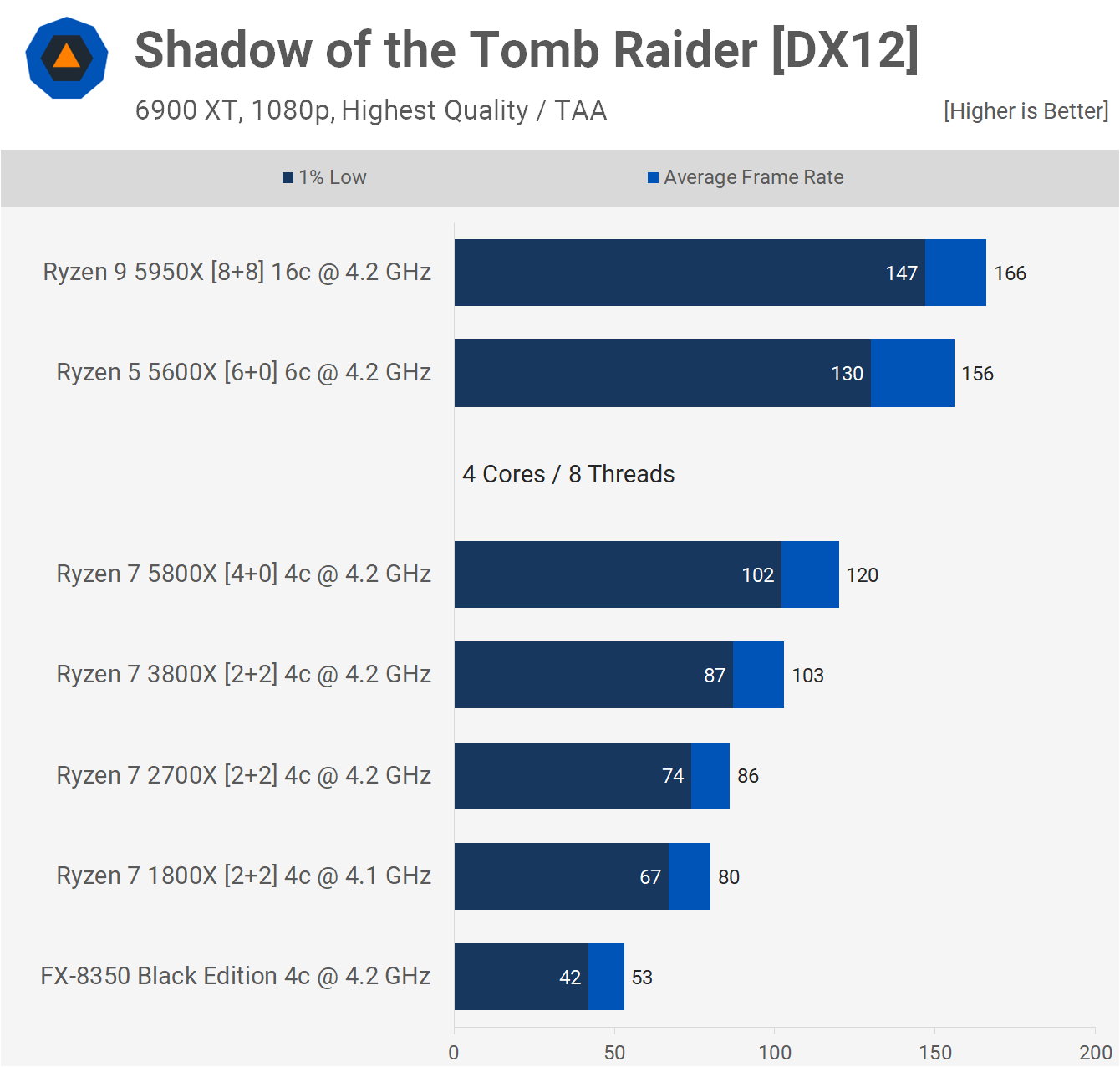
Shadow of the Tomb Raider is another DX12 title that's very CPU demanding. For testing we don't use the built-in benchmark as it's more of a GPU test, instead we test in a large village which increases CPU load dramatically.
Here the FX-8350 kind of delivers playable performance, depending on your standard. For a single player game I'd say it's playable but not desirable considering we're using a very fast GPU like the Radeon RX 6900 XT. This meant that the Ryzen 7 1800X was able to improve 1% low performance by 51%, a massive generational improvement, made possible by the fact that the FX series was a dumpster fire that AMD took 6 years to put out and even then the stench hung around for another year or so.
AMD was really away with the arrival of Zen 2, which boosted performance over the 1800X by almost 30% when matched at the same core and clock frequency, which was never the case as TSMC's 7nm process clocked much better. By the time Zen 3 came out, AMD was offering 126% more performance than the FX-8350 when matching the core count and clock frequency.
But with 6-cores enabled we're looking at a further 30% increase and then a 38% increase with the 5950X. So the 5950X is 213% faster than the FX-8350 when comparing the average frame rate and 250% faster when comparing the 1% low result. So yeah, it's a bit faster.
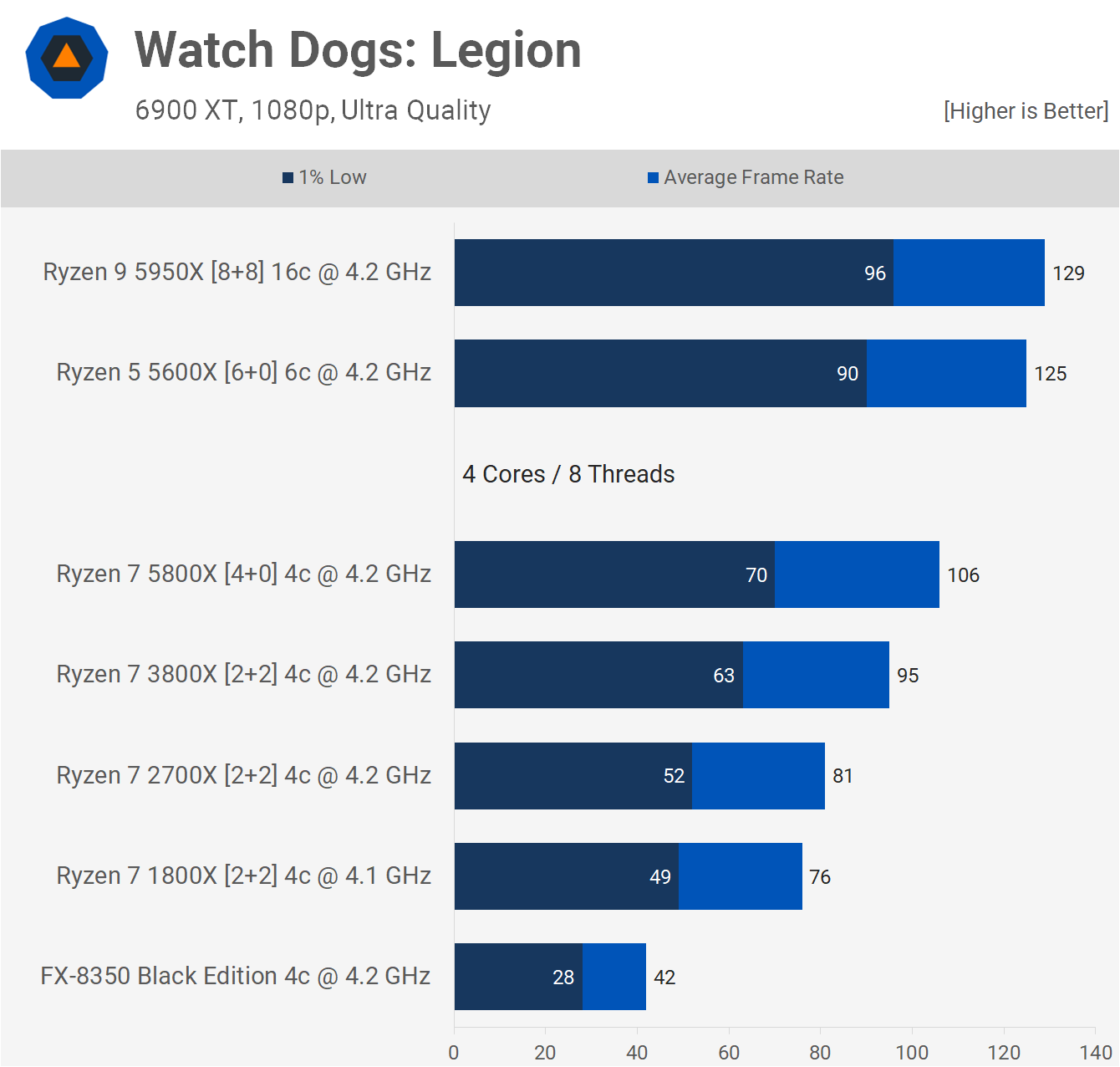
Last up we have Watch Dogs Legion which is also CPU demanding and thus crushed the FX-8350 to the point where I'd say it wasn't entirely playable with a 1% low of just 28 fps. The 1800X with half its cores enabled blasted ahead with 76 fps on average, an 81% performance uplift.
After that we see a massive 126% performance uplift with the 3800X and 152% with the 5800X, again with only 4 cores enabled. Jumping up from quad Zen 3 cores to 6 nets us an improvement of 18% when looking at the average frame rate, or 29% for the 1% low. The jump from 6 to 16 cores doesn't do much in this title and we're miles off that kind of processing power being a requirement for gaming.
Performance Summary
As expected from AMD's dark days of the FX series, the company has made serious performance improvements with Ryzen and finally managed to overtake Intel with Zen 3, though Intel is expected to strike back with Alder Lake (12th gen Core series) shortly.
Before we go any further with this discussion, let's take a look at the average performance seen across the 9 games tested.

On average, the FX-8350 was good for 70 fps with a 1% low of 47 fps. In comparison the Zen architecture represented by the 1800X with half the cores disabled, but a fairly substantial frequency boost, improved clock for clock performance by a whopping 60%, or 70% if we look at the 1% low results. That's a mega generational performance improvement and although the 1800X didn't come clocked at 4.1 GHz and only the best silicon made it to that frequency, that remains a massive architectural improvement when matched at the same clock speed.
Even if we were to wind the 1800X down to 3.6 GHz, which is a 12% frequency reduction, you'd only expect to see around a 10% drop in performance. However you slice it, 1st-gen Ryzen was a monumental upgrade for AMD.
Then from Zen to Zen+ we see another 10% boost. This time the 4.2 GHz frequency was more realistic from an out of the box product perspective. AMD managed a further 15% increase with Zen 2 and then 17% more with Zen 3. Those are solid clock for clock gains seen across Ryzen generations.
An Impressive Run
It's crazy to see AMD's progress over the last decade and how much catch up it had to do to finally knock at Intel's door with 3rd-gen Ryzen. At the time Intel was plucking away with Coffee Lake which architecturally was just Skylake from 2 years prior.
Back in 2016, a year before the release of the first Ryzen processors, AMD was relying on parts like the FX-8350 to fight against Skylake; CPUs like the 4C/4T 6600K and 4C/8T 6700K, AMD struggled to keep pace even with the Core i3 dual cores of the time as most games only required an Intel 2C/4T CPU.
Roughly speaking, the i7-6700K is equivalent to the 3800X when locked at the same frequency and core count. Which means, there was a period of time that if you removed GPU limits, Intel processors offered ~100% more performance. This is why the FX-8350, which realistically was the flagship part of the series, came in cheaper than Intel's fastest Core i5's and at that price it was still a terrible buy.
Since then, AMD's made serious inroads with Ryzen, boosting performance by ~50% from the 1000 series to the 5000 series when matched at the same frequency. Given Zen 3 clocks higher and has 12 and 16-core models, the true performance uplift is much greater.
In case you're asking yourself "where are the power consumption figures?," we prefer not to include them in these "for science" type benchmarks because they're horribly inaccurate and no real conclusions can be drawn from them. This is because parts like the 1800X are heavily overclocked and as such were fed a serious amount of voltage to achieve stability, while the 5800X was essentially underclocked. Power measurements are best performance at stock, allowing us to make a performance per watt comparison, and you can already find that information in the day one reviews for these parts.
Granted, you can't compare Intel's 10% architectural gains over the past six years to AMD's 50% uplift over the past four, because they were coming from two very different starting points and it's taken them a very long time to get back on top.

